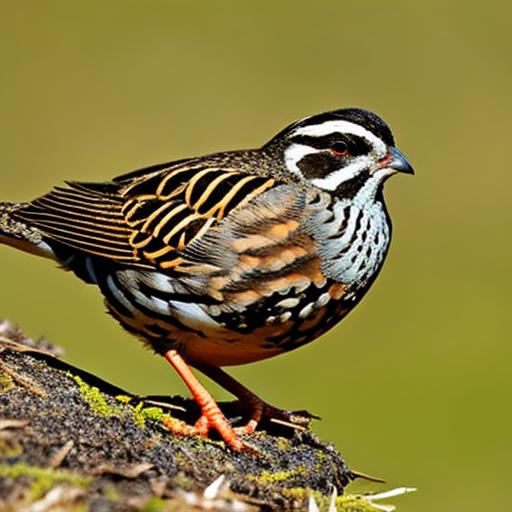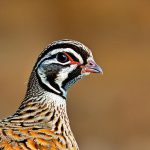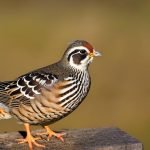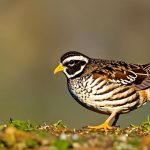When it comes to selecting the right ground for quail, there are several factors to consider. First and foremost, it’s important to choose a location that is free from predators and other potential threats to the quail. This means selecting an area that is well-protected and secure, such as a fenced-in yard or an enclosed aviary. Additionally, the ground should be relatively flat and free from any sharp objects or hazards that could potentially harm the quail.
Another important consideration when selecting the right ground for quail is the type of soil and vegetation present. Quail thrive in areas with a mix of grasses, shrubs, and other ground cover that provide both food and shelter. It’s important to choose a location with a diverse range of plant life to ensure that the quail have access to the nutrients they need to thrive. Additionally, the soil should be well-draining to prevent waterlogging, which can lead to health issues for the quail. Overall, selecting the right ground for quail involves finding a secure, predator-free location with diverse vegetation and well-draining soil.
When it comes to selecting the right ground for quail, there are several important factors to consider. First and foremost, it’s crucial to choose a location that is safe and secure for the quail. This means selecting an area that is well-protected from predators and other potential threats, such as a fenced-in yard or an enclosed aviary. Additionally, the ground should be relatively flat and free from any hazards that could potentially harm the quail, such as sharp objects or toxic plants.
In addition to safety and security, the type of soil and vegetation present is also an important consideration when selecting the right ground for quail. Quail thrive in areas with a mix of grasses, shrubs, and other ground cover that provide both food and shelter. It’s important to choose a location with a diverse range of plant life to ensure that the quail have access to the nutrients they need to thrive. Additionally, the soil should be well-draining to prevent waterlogging, which can lead to health issues for the quail. Overall, selecting the right ground for quail involves finding a secure, predator-free location with diverse vegetation and well-draining soil.
Key Takeaways
- Select a ground with suitable vegetation and cover for quail to thrive
- Create a safe and secure environment by using fencing and predator-proofing measures
- Provide adequate shelter such as brush piles or low shrubs for quail to hide and nest
- Ensure proper nutrition by offering a balanced diet and access to grit and calcium
- Manage health and hygiene by keeping the ground clean and monitoring for signs of illness
- Regularly monitor and maintain the ground to ensure it remains suitable for quail
- Consider the benefits of keeping quail on the ground, such as natural foraging and reduced stress, while also considering potential challenges like predation and disease management
Creating a Safe and Secure Environment for Quail on the Ground
Creating a safe and secure environment for quail on the ground is essential for their health and well-being. One of the most important aspects of this is predator-proofing the area where the quail will be kept. This can be achieved by using wire mesh or netting to enclose the space and prevent access by predators such as foxes, raccoons, and birds of prey. Additionally, it’s important to regularly inspect the enclosure for any signs of damage or potential entry points for predators.
Another key aspect of creating a safe environment for quail on the ground is providing adequate shelter and hiding spots. This can be achieved by incorporating natural features such as shrubs, bushes, and tall grasses into the environment, as well as providing artificial shelters such as wooden boxes or overturned buckets. These hiding spots provide the quail with a place to escape from predators and seek refuge during inclement weather.
In addition to predator-proofing and providing shelter, it’s important to ensure that the ground itself is safe for the quail. This means removing any potential hazards such as sharp objects, toxic plants, or standing water. Regular maintenance of the ground area is also important to prevent the buildup of debris or waste that could pose a health risk to the quail. Overall, creating a safe and secure environment for quail on the ground involves predator-proofing the area, providing adequate shelter, and ensuring that the ground itself is free from hazards.
Creating a safe and secure environment for quail on the ground is crucial for their overall well-being. One of the most important aspects of this is predator-proofing the area where the quail will be kept. This can be achieved by using wire mesh or netting to enclose the space and prevent access by predators such as foxes, raccoons, and birds of prey. Regular inspections of the enclosure should be conducted to check for any signs of damage or potential entry points for predators.
Another key aspect of creating a safe environment for quail on the ground is providing adequate shelter and hiding spots. This can be achieved by incorporating natural features such as shrubs, bushes, and tall grasses into the environment, as well as providing artificial shelters such as wooden boxes or overturned buckets. These hiding spots provide the quail with a place to escape from predators and seek refuge during inclement weather.
In addition to predator-proofing and providing shelter, it’s important to ensure that the ground itself is safe for the quail. This means removing any potential hazards such as sharp objects, toxic plants, or standing water. Regular maintenance of the ground area is also important to prevent the buildup of debris or waste that could pose a health risk to the quail. Overall, creating a safe and secure environment for quail on the ground involves predator-proofing the area, providing adequate shelter, and ensuring that the ground itself is free from hazards.
Providing Adequate Shelter for Quail on the Ground
Providing adequate shelter for quail on the ground is essential for their comfort and well-being. Quail are ground-dwelling birds that rely on cover to hide from predators and seek refuge during inclement weather. One effective way to provide shelter for quail is by incorporating natural features such as shrubs, bushes, and tall grasses into their environment. These natural hiding spots not only provide protection from predators but also offer shade and protection from harsh weather conditions.
In addition to natural shelters, it’s also beneficial to provide artificial shelters for quail on the ground. This can include structures such as wooden boxes, overturned buckets, or specially designed quail shelters. These artificial shelters offer additional protection and security for the quail, particularly in areas where natural cover may be limited. It’s important to place these shelters strategically throughout the quail’s environment to ensure that they have easy access to hiding spots no matter where they are in their enclosure.
Another important aspect of providing adequate shelter for quail on the ground is ensuring that their living space offers protection from extreme temperatures. This can be achieved by providing shade during hot weather and windbreaks during cold weather. Additionally, it’s important to monitor their sheltered areas regularly to ensure that they remain safe and secure for the quail. Overall, providing adequate shelter for quail on the ground involves incorporating natural and artificial shelters into their environment and ensuring that they are protected from extreme temperatures.
Providing adequate shelter for quail on the ground is crucial for their overall well-being. Quail are ground-dwelling birds that rely on cover to hide from predators and seek refuge during inclement weather. One effective way to provide shelter for quail is by incorporating natural features such as shrubs, bushes, and tall grasses into their environment. These natural hiding spots not only provide protection from predators but also offer shade and protection from harsh weather conditions.
In addition to natural shelters, it’s also beneficial to provide artificial shelters for quail on the ground. This can include structures such as wooden boxes, overturned buckets, or specially designed quail shelters. These artificial shelters offer additional protection and security for the quail, particularly in areas where natural cover may be limited. It’s important to place these shelters strategically throughout the quail’s environment to ensure that they have easy access to hiding spots no matter where they are in their enclosure.
Another important aspect of providing adequate shelter for quail on the ground is ensuring that their living space offers protection from extreme temperatures. This can be achieved by providing shade during hot weather and windbreaks during cold weather. Additionally, it’s important to monitor their sheltered areas regularly to ensure that they remain safe and secure for the quail. Overall, providing adequate shelter for quail on the ground involves incorporating natural and artificial shelters into their environment and ensuring that they are protected from extreme temperatures.
Ensuring Proper Nutrition for Quail on the Ground
Ensuring proper nutrition for quail on the ground is essential for their overall health and well-being. Quail are omnivorous birds that require a balanced diet consisting of seeds, grains, insects, and green vegetation. One effective way to provide nutrition for quail on the ground is by offering a commercial game bird feed specifically formulated for their dietary needs. These feeds typically contain a mix of grains, seeds, vitamins, and minerals that are essential for quail health.
In addition to commercial feeds, it’s also beneficial to supplement their diet with fresh greens such as lettuce, spinach, or kale, as well as small amounts of fruits such as berries or melons. These fresh foods provide additional nutrients and variety to their diet, helping to keep them healthy and satisfied. It’s important to monitor their food intake regularly to ensure that they are consuming an adequate amount of nutrition each day.
Another important aspect of ensuring proper nutrition for quail on the ground is providing access to grit or small stones. Quail require grit in their diet to aid in digestion, particularly when consuming hard seeds or grains. Providing access to grit allows them to naturally regulate their digestive system and ensures that they are able to extract maximum nutrition from their food.
Overall, ensuring proper nutrition for quail on the ground involves offering a balanced diet of commercial game bird feed, supplemented with fresh greens and fruits, as well as providing access to grit or small stones.
Ensuring proper nutrition for quail on the ground is crucial for their overall health and well-being. Quail are omnivorous birds that require a balanced diet consisting of seeds, grains, insects, and green vegetation. One effective way to provide nutrition for quail on the ground is by offering a commercial game bird feed specifically formulated for their dietary needs. These feeds typically contain a mix of grains, seeds, vitamins, and minerals that are essential for quail health.
In addition to commercial feeds, it’s also beneficial to supplement their diet with fresh greens such as lettuce, spinach, or kale, as well as small amounts of fruits such as berries or melons. These fresh foods provide additional nutrients and variety to their diet, helping to keep them healthy and satisfied. It’s important to monitor their food intake regularly to ensure that they are consuming an adequate amount of nutrition each day.
Another important aspect of ensuring proper nutrition for quail on the ground is providing access to grit or small stones. Quail require grit in their diet to aid in digestion, particularly when consuming hard seeds or grains. Providing access to grit allows them to naturally regulate their digestive system and ensures that they are able to extract maximum nutrition from their food.
Overall, ensuring proper nutrition for quail on the ground involves offering a balanced diet of commercial game bird feed, supplemented with fresh greens and fruits, as well as providing access to grit or small stones.
Managing Health and Hygiene for Quail on the Ground
Managing health and hygiene for quail on the ground is essential for preventing disease and maintaining their overall well-being. One important aspect of this is regular monitoring of their health through observation of their behavior and physical condition. This includes watching for signs of illness or injury such as lethargy, loss of appetite, abnormal droppings, or feather loss. Any changes in behavior or appearance should be promptly addressed by a veterinarian with experience in avian care.
Another key aspect of managing health and hygiene for quail on the ground is maintaining clean living conditions within their enclosure. This includes regularly removing waste material such as droppings or uneaten food, as well as cleaning waterers and feeders regularly to prevent bacterial growth. Additionally, it’s important to regularly inspect their living space for any potential hazards or sources of contamination that could pose a risk to their health.
In addition to monitoring their health and maintaining clean living conditions, it’s also important to provide regular preventative care such as vaccinations or parasite control as recommended by a veterinarian. This helps to protect them from common diseases and parasites that can affect their health.
Overall, managing health and hygiene for quail on the ground involves regular monitoring of their health, maintaining clean living conditions within their enclosure, and providing regular preventative care as recommended by a veterinarian.
Managing health and hygiene for quail on the ground is essential for preventing disease and maintaining their overall well-being. One important aspect of this is regular monitoring of their health through observation of their behavior and physical condition. This includes watching for signs of illness or injury such as lethargy, loss of appetite, abnormal droppings, or feather loss. Any changes in behavior or appearance should be promptly addressed by a veterinarian with experience in avian care.
Another key aspect of managing health and hygiene for quail on the ground is maintaining clean living conditions within their enclosure. This includes regularly removing waste material such as droppings or uneaten food, as well as cleaning waterers and feeders regularly to prevent bacterial growth. Additionally, it’s important to regularly inspect their living space for any potential hazards or sources of contamination that could pose a risk to their health.
In addition to monitoring their health and maintaining clean living conditions, it’s also important to provide regular preventative care such as vaccinations or parasite control as recommended by a veterinarian. This helps to protect them from common diseases and parasites that can affect their health.
Overall, managing health and hygiene for quail on the ground involves regular monitoring of their health, maintaining clean living conditions within their enclosure, and providing regular preventative care as recommended by a veterinarian.
Monitoring and Maintaining Quail on the Ground
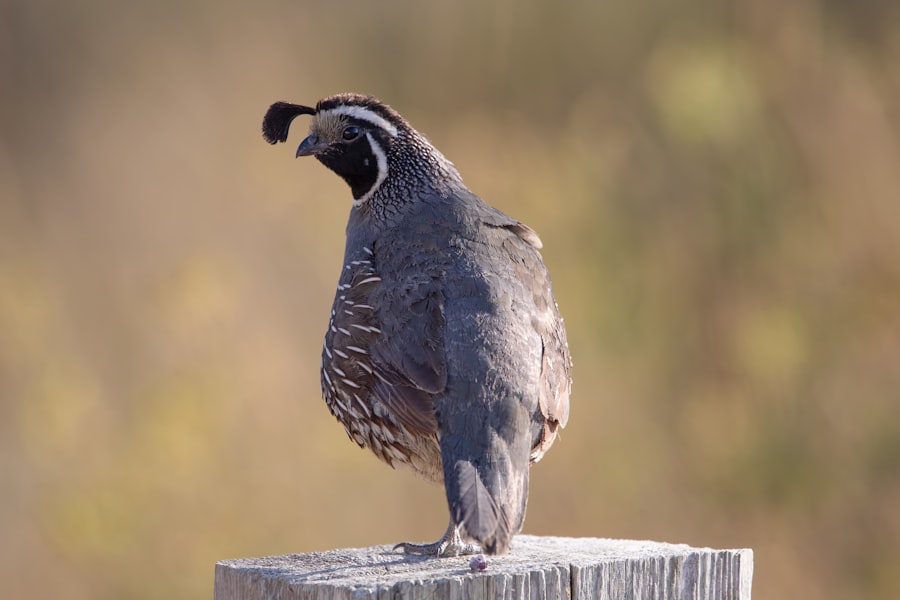
Monitoring and maintaining quail on the ground involves regular observation of their behavior and physical condition in order to ensure their overall well-being. This includes watching for signs of illness or injury such as lethargy, loss of appetite, abnormal droppings, or feather loss. Any changes in behavior or appearance should be promptly addressed by a veterinarian with experience in avian care.
In addition to monitoring their health, it’s also important to maintain clean living conditions within their enclosure by regularly removing waste material such as droppings or uneaten food. Cleaning waterers and feeders regularly helps prevent bacterial growth while also ensuring that they have access to clean water and food at all times.
Regular inspections of their living space should also be conducted in order to identify any potential hazards or sources of contamination that could pose a risk to their health. This includes checking for any damaged fencing or netting that could allow predators access into their enclosure.
Overall, monitoring and maintaining quail on the ground involves regular observation of their health and behavior while also maintaining clean living conditions within their enclosure.
Monitoring and maintaining quail on the ground involves regular observation of their behavior and physical condition. This includes watching for signs of illness or injury, ensuring they have access to clean water and appropriate food, and providing suitable shelter. It is important to also monitor the overall population and breeding success to ensure the long-term health and sustainability of the quail population. Regular monitoring and maintenance are essential for the well-being of quail in a managed environment.
If you’re interested in keeping quail on the ground, you may also want to explore the article on caring for goslings at Poultry Wizard. Understanding the care and maintenance of different poultry species can provide valuable insights and help you create a well-rounded approach to raising birds on your property.
FAQs
What are the benefits of keeping quail on the ground?
Quail kept on the ground have access to natural foraging and can exhibit more natural behaviors, leading to better overall health and well-being.
What type of housing is suitable for keeping quail on the ground?
A suitable housing for ground-kept quail should provide protection from predators, adequate ventilation, and space for foraging and dust bathing.
What should be considered when setting up a ground-based quail enclosure?
Consider the type of soil, drainage, and vegetation in the area, as well as the need for protection from predators and access to clean water and food.
What are the potential challenges of keeping quail on the ground?
Challenges may include predation, disease transmission, and the need for regular maintenance of the enclosure to ensure a clean and safe environment for the quail.
What are some tips for successfully keeping quail on the ground?
Provide ample space for foraging, dust bathing, and shelter, and regularly monitor the health and behavior of the quail to ensure their well-being.
Meet Walter, the feathered-friend fanatic of Florida! Nestled in the sunshine state, Walter struts through life with his feathered companions, clucking his way to happiness. With a coop that’s fancier than a five-star hotel, he’s the Don Juan of the chicken world. When he’s not teaching his hens to do the cha-cha, you’ll find him in a heated debate with his prized rooster, Sir Clucks-a-Lot. Walter’s poultry passion is no yolk; he’s the sunny-side-up guy you never knew you needed in your flock of friends!

